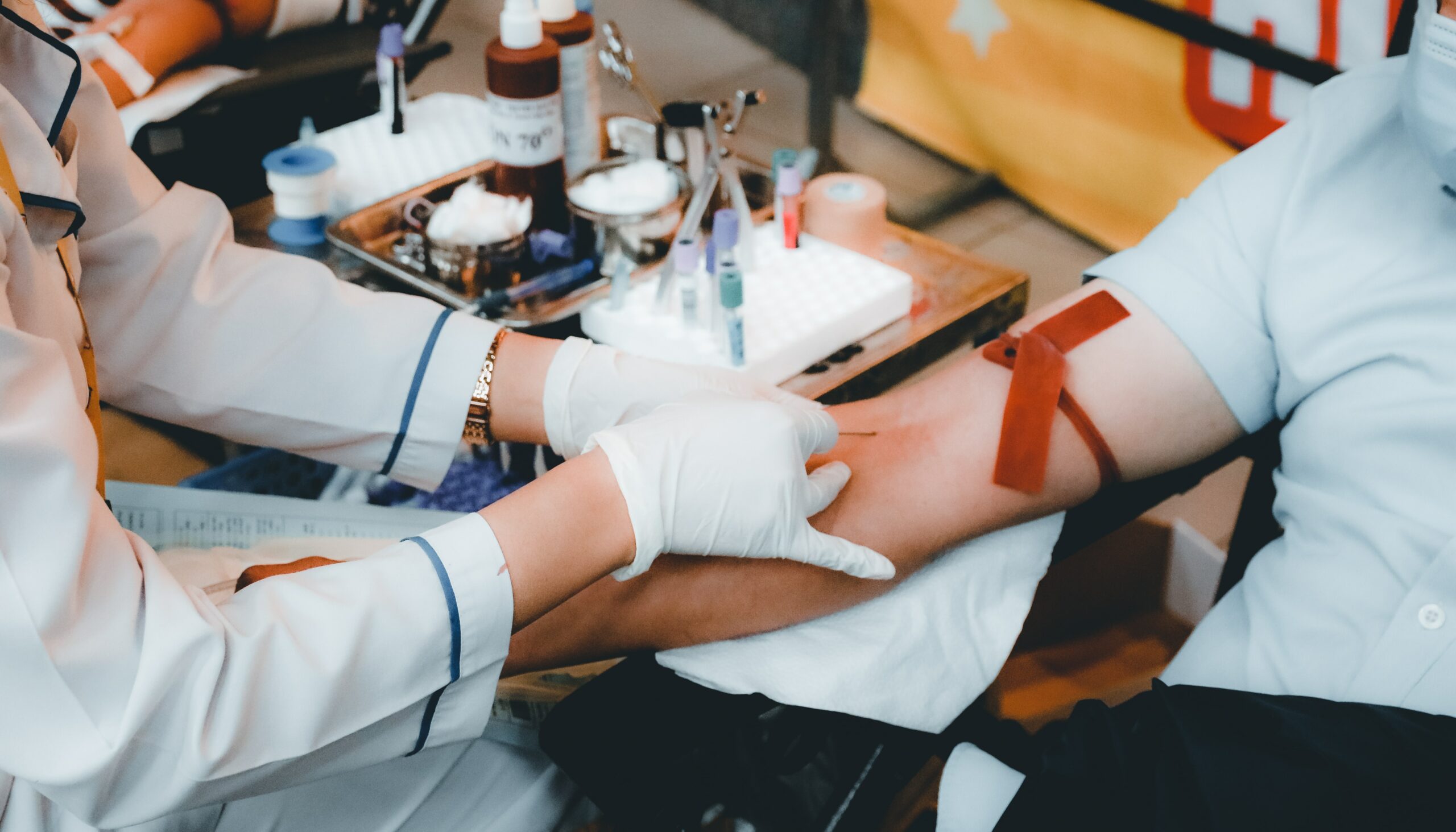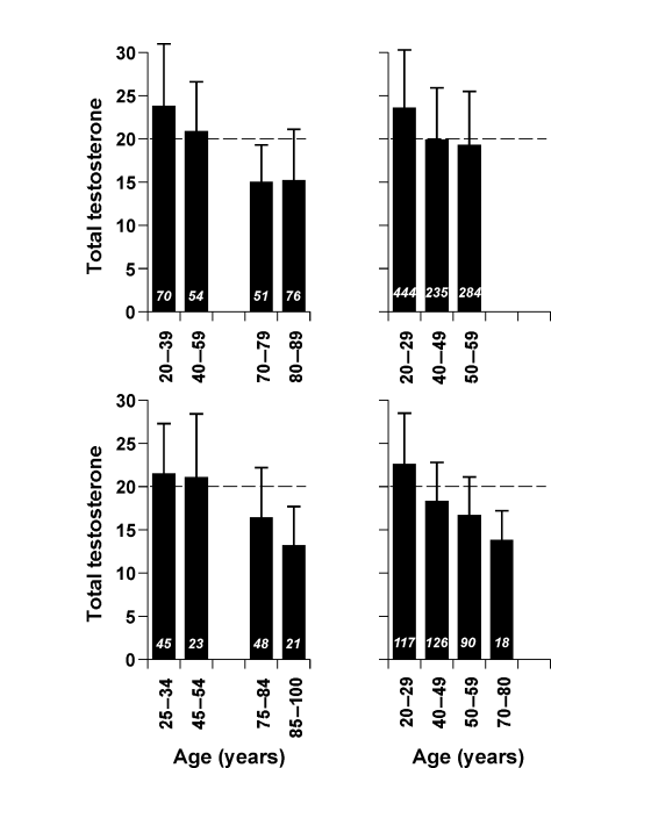What are normal male testosterone levels?
If you’re wondering whether you may have low testosterone or not, your first question is almost certainly going to be: what are normal testosterone levels? The answer is not as simple as you might think.
What is testosterone?
To start with the basics, testosterone is the hormone or ‘chemical messenger’ responsible for normal sexual development and function in men. However, its role in men’s bodies is wider ranging than that. The level and effectiveness of testosterone can have an impact on many aspects of men’s health, from their ability to get erections and enjoy sex to the strength of their bones and the functioning of the brain.
How are testosterone levels measured?
While testosterone can be measured through saliva or a fingerprick capillary blood sample taken at home by the patient, the most reliable and accurate method is via a venous (i.e from a vein) blood sample taken by a qualified phlebotomist.
You need to be fasting when the sample is taken to ensure an accurate measure of your male hormone levels. This is because your glucose levels can affect the body’s production of testosterone, which drops after a meal. So it is best to take the sample in the morning before you have eaten or drunk anything.
Another reason for taking the samples in the morning is because men’s testosterone levels fluctuate in a daily cycle and tend, at least in younger men, to be higher in the morning than later in the day (see FAQs) when there is a peak in the male hormone cycle.

Image credit: Nguyễn Hiệp
What units are used to measure testosterone levels?
In the UK, total testosterone is measured in nanomoles per litre (nmol/L), while in the US, nanograms per deciliter (ng/dL) is the preferred unit. This measure is then compared with the so-called reference range for the whole male population to see whether it lies within statistically normal limits. However, the boundaries of what is considered ‘normal’ can vary. For example, in the NHS it can go from six to 27 nmol/L to 10 to 30nmol/L.
Male hormone levels fall with age
There are other problems too. Total testosterone levels decline with age, falling by about 1% a year after the age of 30. So what is ‘normal’ range for man of 70 will not be the same as that for a man 40 years younger, yet the standard ranges usually do not take account of this factor.
More importantly, the usual thresholds for normal male hormone levels take no account of the symptoms a man may be suffering. The levels of testosterone at which these signs of low T appear can be quite high relative to normal ranges, for example up to 15 nmol/L for loss of libido and energy, obesity at between 10 and 12 nmol/L and depression, disturbed sleep, lack of concentration and type two diabetes at between eight and 10 nmol/L.
The male hormone levels chart below shows average total testosterone levels in healthy, non-obese men aged 20 to 100, clearly demonstrating the decline in male hormone levels by age.

Most testosterone can’t be used by the body
To complicate matters still further, while total testosterone is the most frequently quoted measure, most testosterone in the blood is not actually available for use by the body. Around 40-50% is weakly bound to a type of protein called albumin and 50-60% is tightly bound to Sex Hormone Binding Globulin (SHBG), a protein produced by the liver. This means only 1-3% is left circulating as free testosterone.
Free testosterone linked to symptoms
There is evidence that it is this measure of testosterone, which can be calculated from total testosterone using measured levels of SHBG, has a closer relationship with symptoms than total testosterone taken on its own.
Free T falls faster with age
Since SHBG levels in men tend to increase with age, this means that levels of calculated free testosterone are likely to decline faster as a man ages than his total testosterone levels. Researchers estimate this fall off in free testosterone can be as much as 2.3% a year.
Who should receive TRT treatment?
As you can see, given how complex the question of measurement and assessment of testosterone levels is, deciding who could potentially benefit from testosterone replacement therapy is far from simple.
International opinions on testosterone levels vary
Recent research reveals a range of conclusions about who should receive TRT. The British Society for Sexual Medicine guidelines, issued in 2017, suggest levels of total testosterone between eight and 12 nmol/l might require a trial of TRT or free testosterone below 0.225 nmol/l. However, they also say: “Guidelines can never replace clinical expertise when making treatment decisions for individual patients, but rather help to focus decisions and take personal values and preferences and individual circumstances into account”.
US and European doctors: rely on symptoms
In the US, a group of doctors reviewing research on TRT in a commentary in the journal Aging Male, concluded that starting treatment for low testosterone should rely more on symptoms and less on particular thresholds of total testosterone.
Looking at the same question for the Journal of Sexual Medicine, an international group of experts, from the US, Italy and Germany, said that total testosterone had its limits as a diagnostic test and that men’s symptoms were the most important thing. Where symptoms of low testosterone were present, they recommended a trial of TRT even if total testosterone was within the normal range.
Total testosterone part of wider picture
Having a blood test to measure total testosterone is an important starting point in deciding whether a man needs TRT or not. However, it should be part of a full assessment of a man’s health and wellbeing, including comprehensive blood tests and a physical examination. A thorough examination of potential low T symptoms is also necessary in deciding whether a man is suffering from testosterone deficiency or not.
Checks for TRT contraindications
Before treatment can be given, there should also be comprehensive checks carried out to make sure there are no contraindications to testosterone therapy, including locally advanced or metastatic prostate cancer, male breast cancer, raised haematocrit or prostate specific antigen. Men wishing to have children also require different forms of treatment.
Conclusion: Testosterone levels not just one simple number
So total testosterone, although important, needs to be tested alongside other blood markers to get a full understanding of a man’s hormone levels. What is more, it is only one piece in a much larger and more complex male hormonal health and wellbeing puzzle.
Important Note: The Centre for Men’s Health can only offer diagnosis and treatment to patients who are based in the UK or who can attend appointments in our UK clinics in London and Manchester.
Schedule a call with an expertSources:
Diagnosis and Treatment of Testosterone Deficiency: Updated Recommendations From the Lisbon 2018 International Consultation for Sexual Medicine, Sexual Medicine Reviews, October 2019
Abraham Morgentaler, Abdulmaged Traish, Geoffrey Hackett, T Hugh Jones, Ranjith Ramasamy
https://pubmed.ncbi.nlm.nih.gov/31351915/
Association of specific symptoms and metabolic risks with serum testosterone in older men
The Journal of Clinical Endocrinology and Metabolism, November 2006
Michael Zitzmann, Stephanie Faber, Eberhard Nieschlag
https://pubmed.ncbi.nlm.nih.gov/16926258/
https://pubmed.ncbi.nlm.nih.gov/24797325/
Testosterone threshold – does one size fit all?
The Aging Male, Volume 18, 2015
Avinash Maganty, Jonathan E. Shoag & Ranjith Ramasamy
https://pubmed.ncbi.nlm.nih.gov/24797325/
References:
24 hours in the life of a hormone: what time is the right time for a pituitary function test?
Anneke Graf, Endocrinologist, Winter 2019
https://www.endocrinology.org/endocrinologist/134-winter19/features/24-hours-in-the-life-of-a-hormone-what-time-is-the-right-time-for-a-pituitary-function-test/
Modeling Testosterone Circadian Rhythm in Hypogonadal Males: Effect of Age and Circannual Variations, The AAPS Journal January 2016
Mario González-Sales,Olivier Barrière, Pierre-Olivier Tremblay, Fahima Nekka, Julie Desrochers, Mario Tanguay
https://www.ncbi.nlm.nih.gov/pmc/articles/PMC4706275/
Testosterone levels show steady decrease among young US men
Kristie L. Kahl, Urology Times Journal, Vol 48 No 7
https://www.urologytimes.com/view/testosterone-levels-show-steady-decrease-among-young-us-men
The decline of androgen levels in elderly men and its clinical and therapeutic implications
Jean M Kaufman, Alex Vermeulen, Endocrine Reviews, October 2005
https://pubmed.ncbi.nlm.nih.gov/15901667/
Decline in Serum Testosterone Levels Among Adolescent and Young Adult Men in the USA
Soum D Lokeshwar, Premal Patel, Richard J Fantus, Joshua Halpern, Cecilia Chang, Atil Y Kargi, Ranjith Ramasamy, European Urology Focus July 2021
https://pubmed.ncbi.nlm.nih.gov/32081788/
- Is there a male hormone cycle?
-
Yes, there is a male hormone cycle, but on a daily rather than on a monthly basis. In men under 40, testosterone levels can fluctuate quite markedly, with variations of up to 30-35% between morning and mid- to late afternoon in men who are 30-40 years old. The so-called ‘blunting’ of this male daily hormone cycle with age means that by 70 this variation has fallen to around 10%.
- What is male hormone imbalance?
-
While some clinics in the UK may refer to ‘male hormone imbalance’, it is not a term specialists at the Centre for Men’s Health either use or recognise, since it is not technically correct. What they are actually referring to when they talk about male hormone imbalance is a relative or absolute insufficiency of testosterone or its availability and activity in the body, which can occur for a wide number of reasons related to health problems or lifestyle factors.
- Are men’s testosterone levels falling over time?
-
There is evidence that men’s testosterone levels are falling over time. According to one study of adolescent and young adult men in the US, between 1999 and 2016, average testosterone levels fell from 21 nmol/l to 15.6nmol/l. While some of this change may be due to the way the tests were carried out, the authors of the study said potential causes of the decline could include increased obesity, dietary changes, reduced exercise and physical activity, marijuana use and environmental toxins. Studies of older men also suggest a similar pattern of falling male hormone levels over time.
